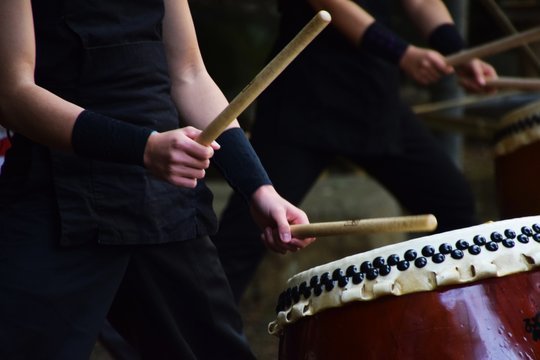Taiko (太鼓) is a general term used to describe Japanese percussion instruments. In Japan, taiko has been used since as early as 10,000 B.C.E. to call soldiers to battle and then evolved to be an important part of sacred rituals.[1] An ensemble of taiko drumming, as it is most commonly performed today, is called kumi-daiko (組太鼓, translated, “set of drums”). Taiko drums can be heard from long distances due to the up to 120dB sound they create which is equivalent to a jet engine.[2]
Taiko has a mythological origin in Japanese folklore, but historical records suggest that taiko similar to those of today was introduced to Japan as early as the 6th century C.E. from India with influences from Chinese and Korean cultures.[3] Their function has varied throughout history, ranging from communication, military action, theatrical accompaniment, religious ceremonies, festivals, and concert performances. Methods of playing taiko were inherited under the iemoto system (the teaching of traditional Japanese art by a master).[4] Today, anyone can learn taiko and enjoy its thunderous rhythms.
Teien No Taiko, otherwise known as “Drums of the Garden,” is Anderson Japanese Gardens’ very own Taiko Drum Group. They offer weekly lessons to learn about the history and cultural impact of the Taiko drums, and, of course, how to play them! They performed outside the Fabyan Japanese Garden on Sunday, May 5 from 12-3 pm to welcome the opening of the garden for the season!
Thank you for reading! If this story interested, inspired, or informed you, please consider subscribing to our monthly e-newsletter so more of these stories come right to you!
[1] The Travel Show, “Japan’s Ancient Art of Taiko Drumming,” BBC.com, October 20, 2023, https://www.bbc.com/travel/article/20231020-japans-ancient-art-of-taiko-drumming.
[2] Ibid.
[3] “History of Taiko: The Heartbeat of Japan,” Taiko Center Co., LTD, accessed April 30, 2024, https://www.taiko-center.co.jp/english/history_of_taiko.html.
[4] Ibid.

